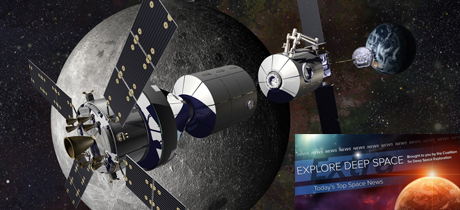In Today’s Deep Space Extra… The International Space Station partners gather in Tokyo to discuss Deep Space Gateway (DSG) collaboration. NASA unveils deep space power sources. Google Lunar X-Prize ends without a winner.
Human Space Exploration
This was a huge week for the NASA-Russia lunar space station and the future of spaceflight
Popular Mechanics (1/24): A meeting in Tokyo among the International Space Station’s major space agency partners, NASA, Europe, Japan, Canada and Russia was focused on plans for a lunar orbiting Deep Space Gateway (DSG), a habitat for astronauts working on lunar surface and Mars exploration strategies, the publication reports. Russia’s contribution could be a multipurpose module to serve as an airlock, lab and docking port. One sticking point is whether the gateway would require common “standards” or “interfaces” for the components provided by the international partners.
NASA unveils new power source for space exploration
Sky and Telescope (1/23): NASA’s Glenn Research Center and the Los Alamos National Laboratory are collaborating in the development of a 10 Kilowatt fission reactor with a decade long service life for deep space applications. “Kilopower opens up the full surface of Mars, including the northern latitudes where water may reside,” said NASA’s Lee Mason. Portable nuclear power would also be ideal for exploring the permanently shadowed polar craters on the moon. “We want a power source that can handle extreme environments,” adds Lee Mason.
Space walkers complete repairs to Space Station robotic arm
Spaceflightnow.com (1/23): NASA spacewalking astronauts Mark Vande Hei and Scott Tingle successfully completed upgrades to the International Space Station’s Canadian robot arm on Tuesday with a seven hour spacewalk. Repairs started with three spacewalk in October replaced two grappling mechanisms called Latching End Effectors. The mechanical arm is a crucial for the moving of experiments and astronauts around the outside of the Space Station for repair, maintenance and research.
Space Science
Juno spacecraft captures stunning images of Jupiter’s cloud tops, storms
Spaceflightinsider.com (1/23): NASA’s Jupiter orbiting Juno mission spacecraft has sent back new images of the large planet’s complex atmosphere and picturesque clouds.
NASA’s Cassini spacecraft shows us how Earth-like Saturn’s moon is
USA Today (1/23): NASA’s long running mission to Saturn ended in 2017. But observations gathered with partners including the European and Italian space agencies suggest far away Saturn’s moon Titan may share qualities like those of Earth.
Other News
Google Lunar X-Prize to end without winner
Space News (1/23): Hinted at in news reports earlier this week, the Google Lunar X-Prize announced Tuesday that its ending a $20 million competition among global contestants to see which commercial company could become the first to land on the moon and carry out brief surface operations. The deadline was Mar. 31, one that had been deferred several times since the competition was announced in 2007.
With the end of Atlas V planned, ULA assumes responsibility for marketing and sales of Atlas V
Coalition Members in the News: Boeing, Lockheed Martin, United Launch Alliance
SpaceflightInsider.com (1/22): United Launch Alliance (ULA) will assume marketing and sales of the Atlas 5 rocket, a responsibility previously held by Lockheed Martin Commercial Launch Services. ULA, a joint venture between Boeing Defense Space & Security and Lockheed Martin, is moving toward the introduction of an Atlas 5 successor called Vulcan.
Universe Today (1/22): Spanish patent holders believe a long, narrow coiled aluminum satellite tether could be used to generate spacecraft electricity or thrust for an aging spacecraft to steer it towards a destructive atmospheric re-entry rather than lingering as orbital space junk.

